Comprehensive Report: Indigenous Health, Cultural Safety, and Policies
VerifiedAdded on 2023/01/09
|8
|2293
|75
Report
AI Summary
This report provides a comprehensive overview of Indigenous and Aboriginal health, addressing key aspects such as cultural safety, historical policies, and the impact of colonization. It explores the importance of creating a safe environment for Aboriginal communities to practice their traditions and the historical context before, during, and after colonization, highlighting the devastating effects on land, health, and social structures. The report analyzes Indigenous health statistics, revealing the disparities in life expectancy and mental health, while also showcasing success stories within the community. Furthermore, it reflects on the implications of these successes for society and emphasizes the crucial role of nursing in addressing health issues within the Aboriginal community, including providing proper care for infections and psychological problems. The report concludes by referencing relevant sources to support the presented information.
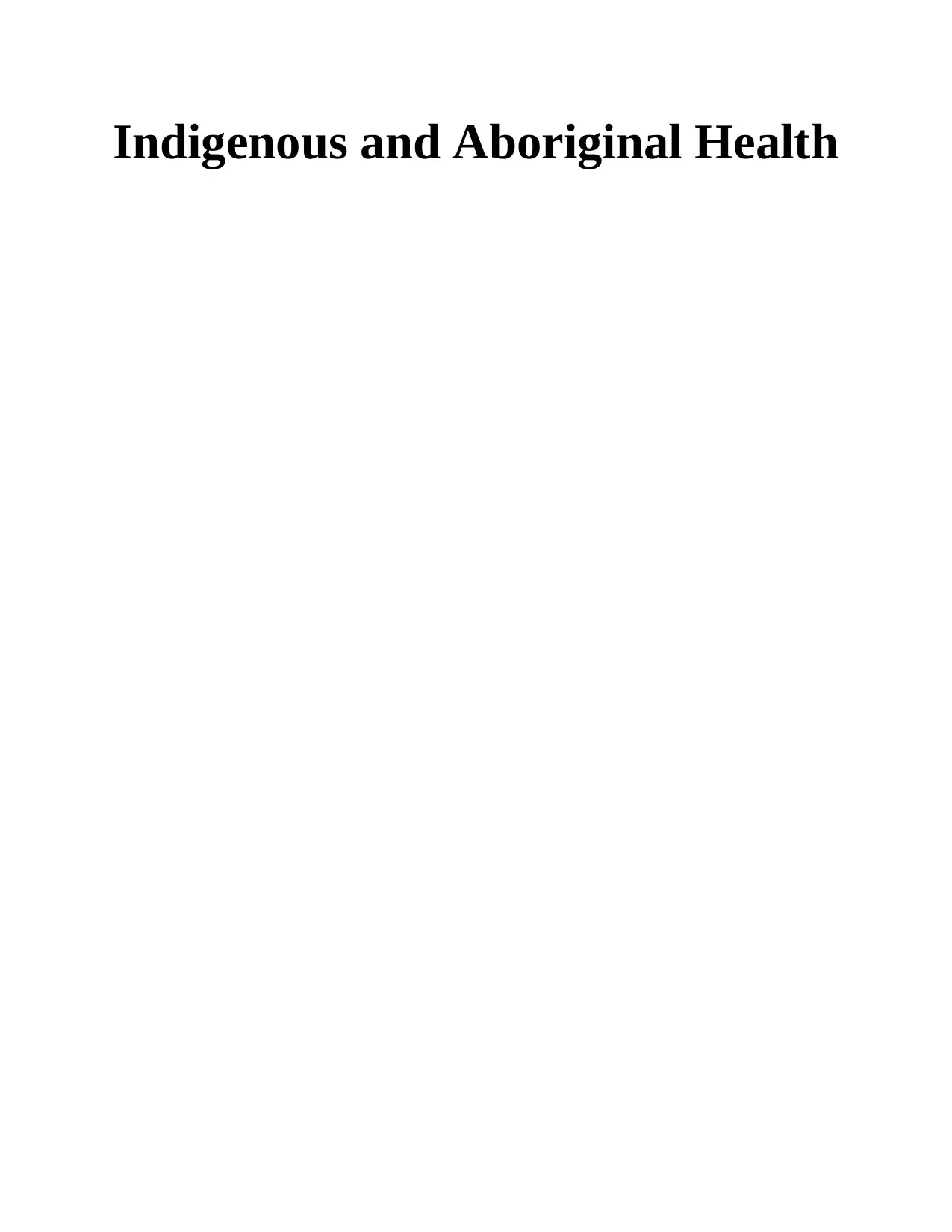
Indigenous and Aboriginal Health
Paraphrase This Document
Need a fresh take? Get an instant paraphrase of this document with our AI Paraphraser
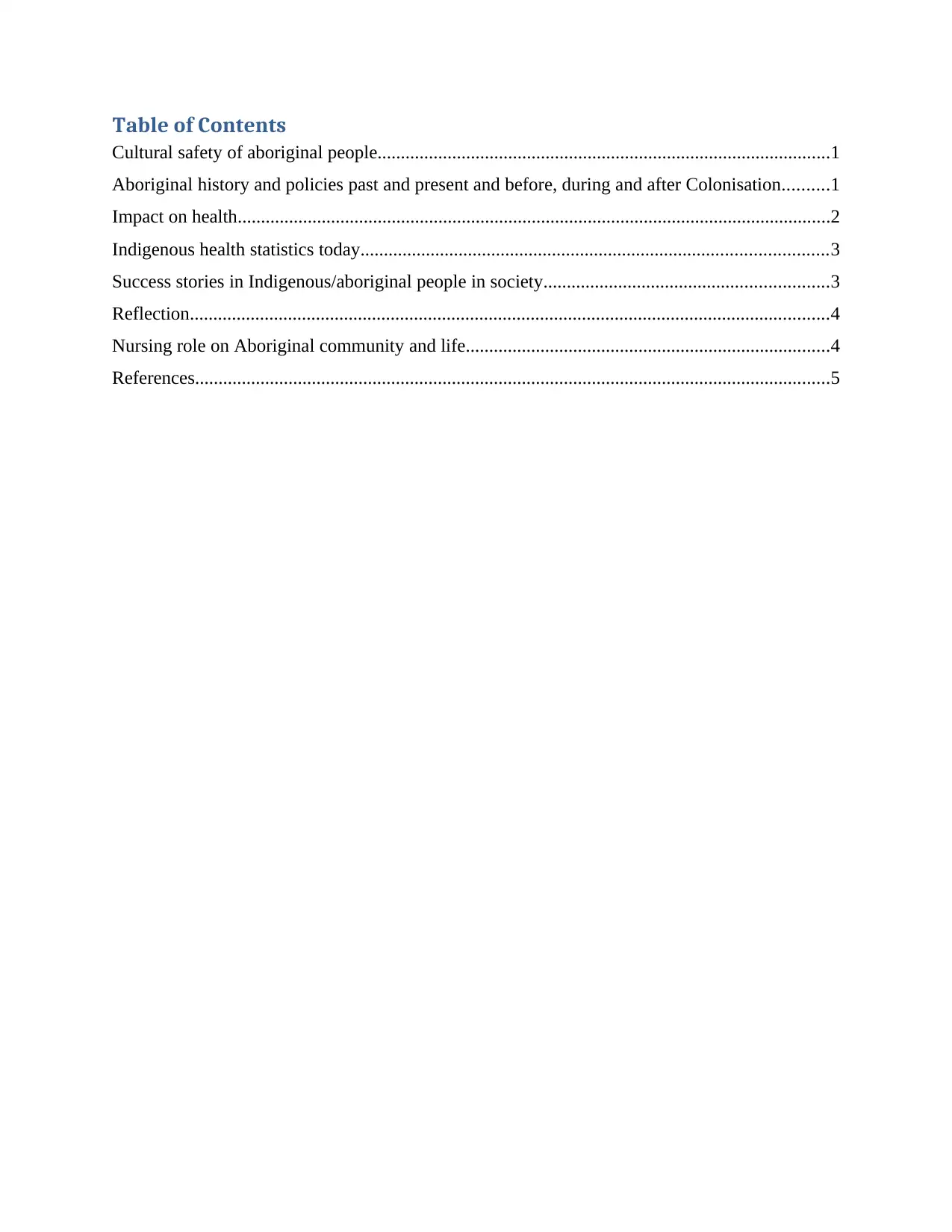
Table of Contents
Cultural safety of aboriginal people.................................................................................................1
Aboriginal history and policies past and present and before, during and after Colonisation..........1
Impact on health...............................................................................................................................2
Indigenous health statistics today....................................................................................................3
Success stories in Indigenous/aboriginal people in society.............................................................3
Reflection.........................................................................................................................................4
Nursing role on Aboriginal community and life..............................................................................4
References........................................................................................................................................5
Cultural safety of aboriginal people.................................................................................................1
Aboriginal history and policies past and present and before, during and after Colonisation..........1
Impact on health...............................................................................................................................2
Indigenous health statistics today....................................................................................................3
Success stories in Indigenous/aboriginal people in society.............................................................3
Reflection.........................................................................................................................................4
Nursing role on Aboriginal community and life..............................................................................4
References........................................................................................................................................5
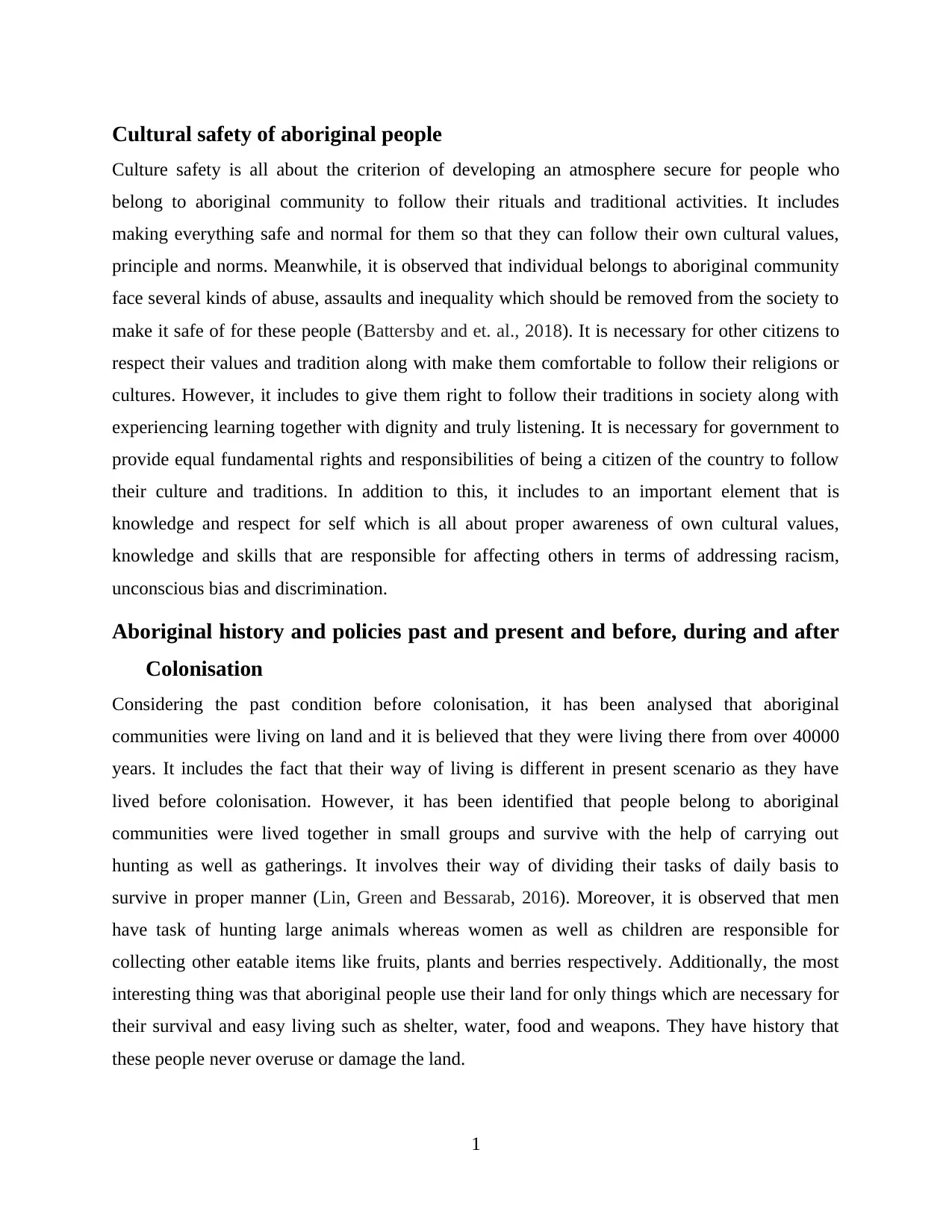
Cultural safety of aboriginal people
Culture safety is all about the criterion of developing an atmosphere secure for people who
belong to aboriginal community to follow their rituals and traditional activities. It includes
making everything safe and normal for them so that they can follow their own cultural values,
principle and norms. Meanwhile, it is observed that individual belongs to aboriginal community
face several kinds of abuse, assaults and inequality which should be removed from the society to
make it safe of for these people (Battersby and et. al., 2018). It is necessary for other citizens to
respect their values and tradition along with make them comfortable to follow their religions or
cultures. However, it includes to give them right to follow their traditions in society along with
experiencing learning together with dignity and truly listening. It is necessary for government to
provide equal fundamental rights and responsibilities of being a citizen of the country to follow
their culture and traditions. In addition to this, it includes to an important element that is
knowledge and respect for self which is all about proper awareness of own cultural values,
knowledge and skills that are responsible for affecting others in terms of addressing racism,
unconscious bias and discrimination.
Aboriginal history and policies past and present and before, during and after
Colonisation
Considering the past condition before colonisation, it has been analysed that aboriginal
communities were living on land and it is believed that they were living there from over 40000
years. It includes the fact that their way of living is different in present scenario as they have
lived before colonisation. However, it has been identified that people belong to aboriginal
communities were lived together in small groups and survive with the help of carrying out
hunting as well as gatherings. It involves their way of dividing their tasks of daily basis to
survive in proper manner (Lin, Green and Bessarab, 2016). Moreover, it is observed that men
have task of hunting large animals whereas women as well as children are responsible for
collecting other eatable items like fruits, plants and berries respectively. Additionally, the most
interesting thing was that aboriginal people use their land for only things which are necessary for
their survival and easy living such as shelter, water, food and weapons. They have history that
these people never overuse or damage the land.
1
Culture safety is all about the criterion of developing an atmosphere secure for people who
belong to aboriginal community to follow their rituals and traditional activities. It includes
making everything safe and normal for them so that they can follow their own cultural values,
principle and norms. Meanwhile, it is observed that individual belongs to aboriginal community
face several kinds of abuse, assaults and inequality which should be removed from the society to
make it safe of for these people (Battersby and et. al., 2018). It is necessary for other citizens to
respect their values and tradition along with make them comfortable to follow their religions or
cultures. However, it includes to give them right to follow their traditions in society along with
experiencing learning together with dignity and truly listening. It is necessary for government to
provide equal fundamental rights and responsibilities of being a citizen of the country to follow
their culture and traditions. In addition to this, it includes to an important element that is
knowledge and respect for self which is all about proper awareness of own cultural values,
knowledge and skills that are responsible for affecting others in terms of addressing racism,
unconscious bias and discrimination.
Aboriginal history and policies past and present and before, during and after
Colonisation
Considering the past condition before colonisation, it has been analysed that aboriginal
communities were living on land and it is believed that they were living there from over 40000
years. It includes the fact that their way of living is different in present scenario as they have
lived before colonisation. However, it has been identified that people belong to aboriginal
communities were lived together in small groups and survive with the help of carrying out
hunting as well as gatherings. It involves their way of dividing their tasks of daily basis to
survive in proper manner (Lin, Green and Bessarab, 2016). Moreover, it is observed that men
have task of hunting large animals whereas women as well as children are responsible for
collecting other eatable items like fruits, plants and berries respectively. Additionally, the most
interesting thing was that aboriginal people use their land for only things which are necessary for
their survival and easy living such as shelter, water, food and weapons. They have history that
these people never overuse or damage the land.
1
⊘ This is a preview!⊘
Do you want full access?
Subscribe today to unlock all pages.

Trusted by 1+ million students worldwide
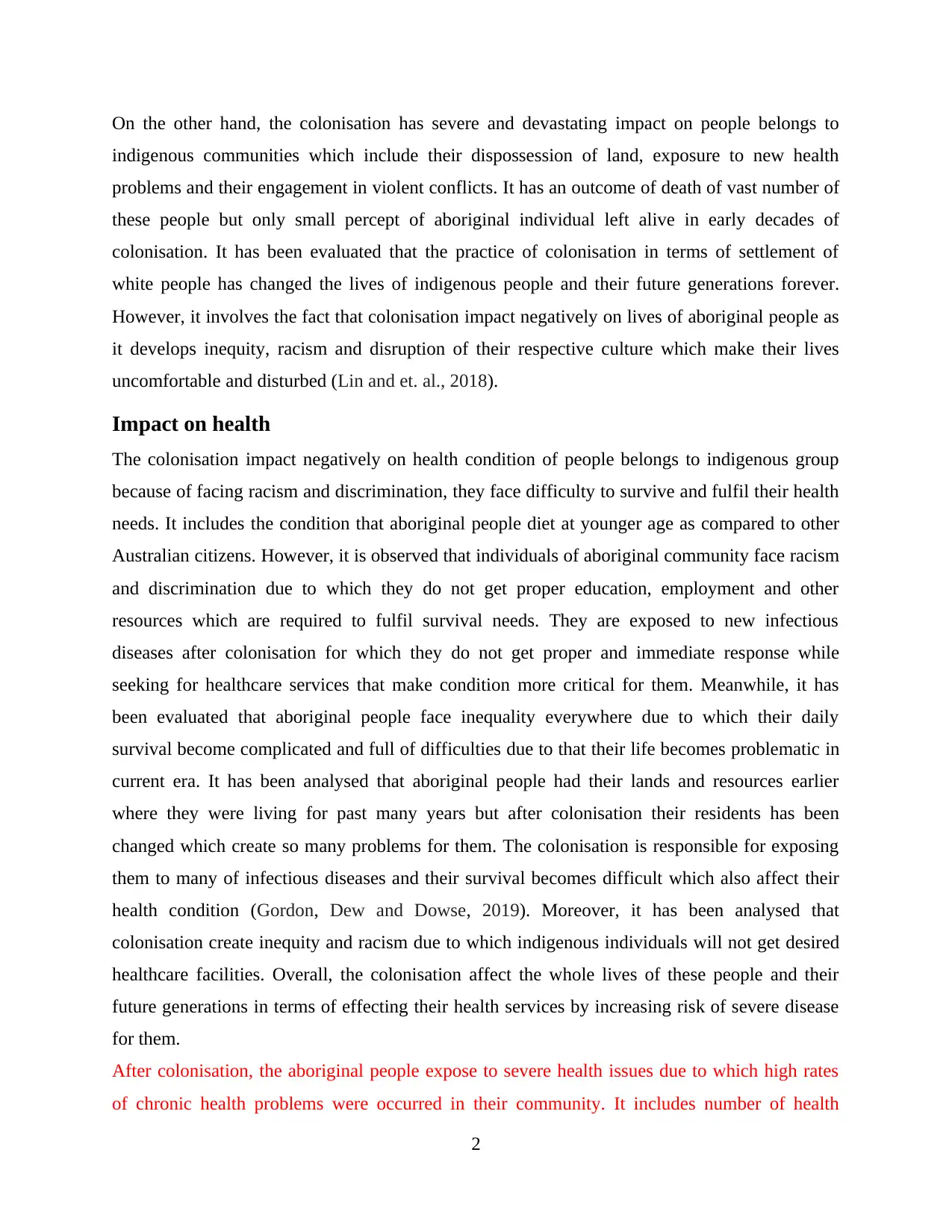
On the other hand, the colonisation has severe and devastating impact on people belongs to
indigenous communities which include their dispossession of land, exposure to new health
problems and their engagement in violent conflicts. It has an outcome of death of vast number of
these people but only small percept of aboriginal individual left alive in early decades of
colonisation. It has been evaluated that the practice of colonisation in terms of settlement of
white people has changed the lives of indigenous people and their future generations forever.
However, it involves the fact that colonisation impact negatively on lives of aboriginal people as
it develops inequity, racism and disruption of their respective culture which make their lives
uncomfortable and disturbed (Lin and et. al., 2018).
Impact on health
The colonisation impact negatively on health condition of people belongs to indigenous group
because of facing racism and discrimination, they face difficulty to survive and fulfil their health
needs. It includes the condition that aboriginal people diet at younger age as compared to other
Australian citizens. However, it is observed that individuals of aboriginal community face racism
and discrimination due to which they do not get proper education, employment and other
resources which are required to fulfil survival needs. They are exposed to new infectious
diseases after colonisation for which they do not get proper and immediate response while
seeking for healthcare services that make condition more critical for them. Meanwhile, it has
been evaluated that aboriginal people face inequality everywhere due to which their daily
survival become complicated and full of difficulties due to that their life becomes problematic in
current era. It has been analysed that aboriginal people had their lands and resources earlier
where they were living for past many years but after colonisation their residents has been
changed which create so many problems for them. The colonisation is responsible for exposing
them to many of infectious diseases and their survival becomes difficult which also affect their
health condition (Gordon, Dew and Dowse, 2019). Moreover, it has been analysed that
colonisation create inequity and racism due to which indigenous individuals will not get desired
healthcare facilities. Overall, the colonisation affect the whole lives of these people and their
future generations in terms of effecting their health services by increasing risk of severe disease
for them.
After colonisation, the aboriginal people expose to severe health issues due to which high rates
of chronic health problems were occurred in their community. It includes number of health
2
indigenous communities which include their dispossession of land, exposure to new health
problems and their engagement in violent conflicts. It has an outcome of death of vast number of
these people but only small percept of aboriginal individual left alive in early decades of
colonisation. It has been evaluated that the practice of colonisation in terms of settlement of
white people has changed the lives of indigenous people and their future generations forever.
However, it involves the fact that colonisation impact negatively on lives of aboriginal people as
it develops inequity, racism and disruption of their respective culture which make their lives
uncomfortable and disturbed (Lin and et. al., 2018).
Impact on health
The colonisation impact negatively on health condition of people belongs to indigenous group
because of facing racism and discrimination, they face difficulty to survive and fulfil their health
needs. It includes the condition that aboriginal people diet at younger age as compared to other
Australian citizens. However, it is observed that individuals of aboriginal community face racism
and discrimination due to which they do not get proper education, employment and other
resources which are required to fulfil survival needs. They are exposed to new infectious
diseases after colonisation for which they do not get proper and immediate response while
seeking for healthcare services that make condition more critical for them. Meanwhile, it has
been evaluated that aboriginal people face inequality everywhere due to which their daily
survival become complicated and full of difficulties due to that their life becomes problematic in
current era. It has been analysed that aboriginal people had their lands and resources earlier
where they were living for past many years but after colonisation their residents has been
changed which create so many problems for them. The colonisation is responsible for exposing
them to many of infectious diseases and their survival becomes difficult which also affect their
health condition (Gordon, Dew and Dowse, 2019). Moreover, it has been analysed that
colonisation create inequity and racism due to which indigenous individuals will not get desired
healthcare facilities. Overall, the colonisation affect the whole lives of these people and their
future generations in terms of effecting their health services by increasing risk of severe disease
for them.
After colonisation, the aboriginal people expose to severe health issues due to which high rates
of chronic health problems were occurred in their community. It includes number of health
2
Paraphrase This Document
Need a fresh take? Get an instant paraphrase of this document with our AI Paraphraser
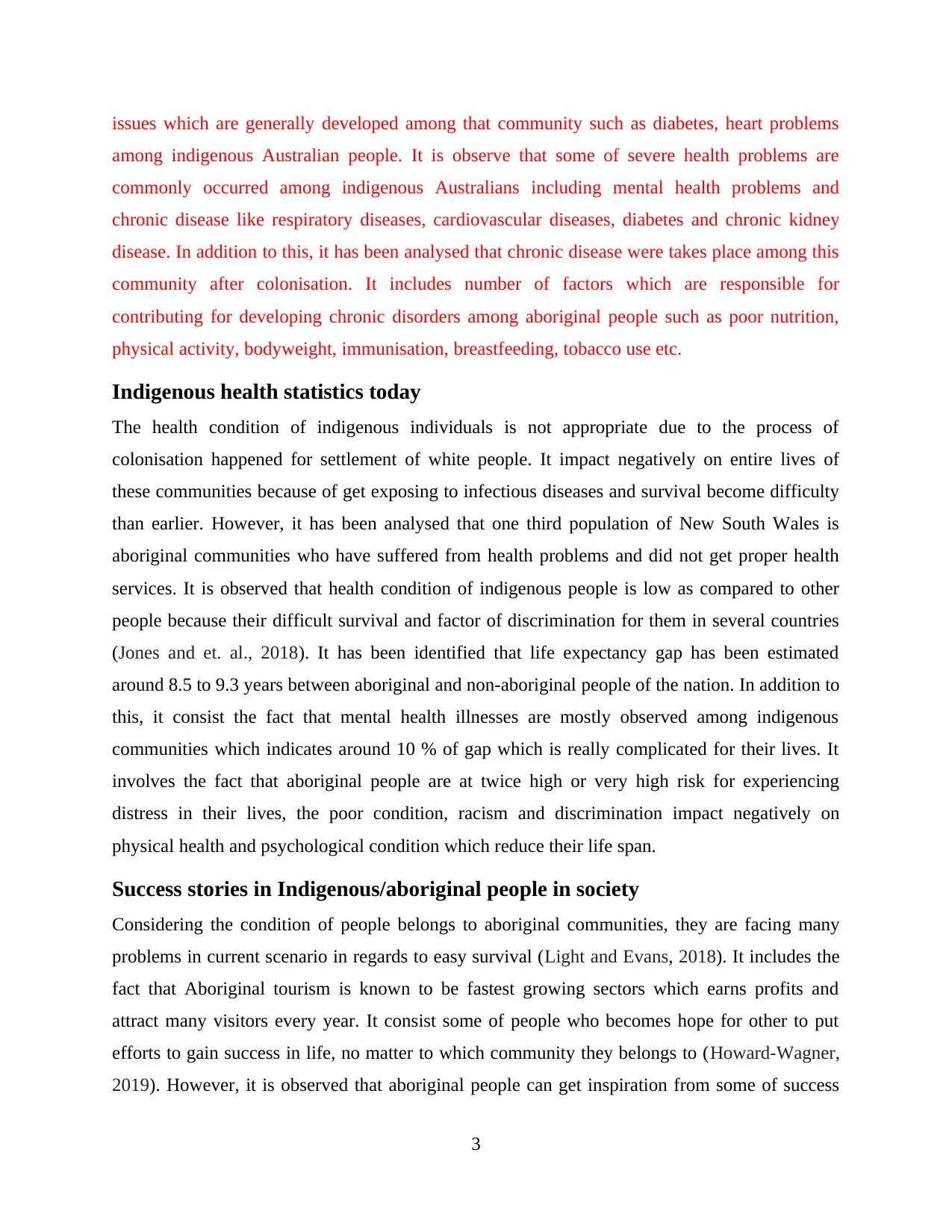
issues which are generally developed among that community such as diabetes, heart problems
among indigenous Australian people. It is observe that some of severe health problems are
commonly occurred among indigenous Australians including mental health problems and
chronic disease like respiratory diseases, cardiovascular diseases, diabetes and chronic kidney
disease. In addition to this, it has been analysed that chronic disease were takes place among this
community after colonisation. It includes number of factors which are responsible for
contributing for developing chronic disorders among aboriginal people such as poor nutrition,
physical activity, bodyweight, immunisation, breastfeeding, tobacco use etc.
Indigenous health statistics today
The health condition of indigenous individuals is not appropriate due to the process of
colonisation happened for settlement of white people. It impact negatively on entire lives of
these communities because of get exposing to infectious diseases and survival become difficulty
than earlier. However, it has been analysed that one third population of New South Wales is
aboriginal communities who have suffered from health problems and did not get proper health
services. It is observed that health condition of indigenous people is low as compared to other
people because their difficult survival and factor of discrimination for them in several countries
(Jones and et. al., 2018). It has been identified that life expectancy gap has been estimated
around 8.5 to 9.3 years between aboriginal and non-aboriginal people of the nation. In addition to
this, it consist the fact that mental health illnesses are mostly observed among indigenous
communities which indicates around 10 % of gap which is really complicated for their lives. It
involves the fact that aboriginal people are at twice high or very high risk for experiencing
distress in their lives, the poor condition, racism and discrimination impact negatively on
physical health and psychological condition which reduce their life span.
Success stories in Indigenous/aboriginal people in society
Considering the condition of people belongs to aboriginal communities, they are facing many
problems in current scenario in regards to easy survival (Light and Evans, 2018). It includes the
fact that Aboriginal tourism is known to be fastest growing sectors which earns profits and
attract many visitors every year. It consist some of people who becomes hope for other to put
efforts to gain success in life, no matter to which community they belongs to (Howard-Wagner,
2019). However, it is observed that aboriginal people can get inspiration from some of success
3
among indigenous Australian people. It is observe that some of severe health problems are
commonly occurred among indigenous Australians including mental health problems and
chronic disease like respiratory diseases, cardiovascular diseases, diabetes and chronic kidney
disease. In addition to this, it has been analysed that chronic disease were takes place among this
community after colonisation. It includes number of factors which are responsible for
contributing for developing chronic disorders among aboriginal people such as poor nutrition,
physical activity, bodyweight, immunisation, breastfeeding, tobacco use etc.
Indigenous health statistics today
The health condition of indigenous individuals is not appropriate due to the process of
colonisation happened for settlement of white people. It impact negatively on entire lives of
these communities because of get exposing to infectious diseases and survival become difficulty
than earlier. However, it has been analysed that one third population of New South Wales is
aboriginal communities who have suffered from health problems and did not get proper health
services. It is observed that health condition of indigenous people is low as compared to other
people because their difficult survival and factor of discrimination for them in several countries
(Jones and et. al., 2018). It has been identified that life expectancy gap has been estimated
around 8.5 to 9.3 years between aboriginal and non-aboriginal people of the nation. In addition to
this, it consist the fact that mental health illnesses are mostly observed among indigenous
communities which indicates around 10 % of gap which is really complicated for their lives. It
involves the fact that aboriginal people are at twice high or very high risk for experiencing
distress in their lives, the poor condition, racism and discrimination impact negatively on
physical health and psychological condition which reduce their life span.
Success stories in Indigenous/aboriginal people in society
Considering the condition of people belongs to aboriginal communities, they are facing many
problems in current scenario in regards to easy survival (Light and Evans, 2018). It includes the
fact that Aboriginal tourism is known to be fastest growing sectors which earns profits and
attract many visitors every year. It consist some of people who becomes hope for other to put
efforts to gain success in life, no matter to which community they belongs to (Howard-Wagner,
2019). However, it is observed that aboriginal people can get inspiration from some of success
3
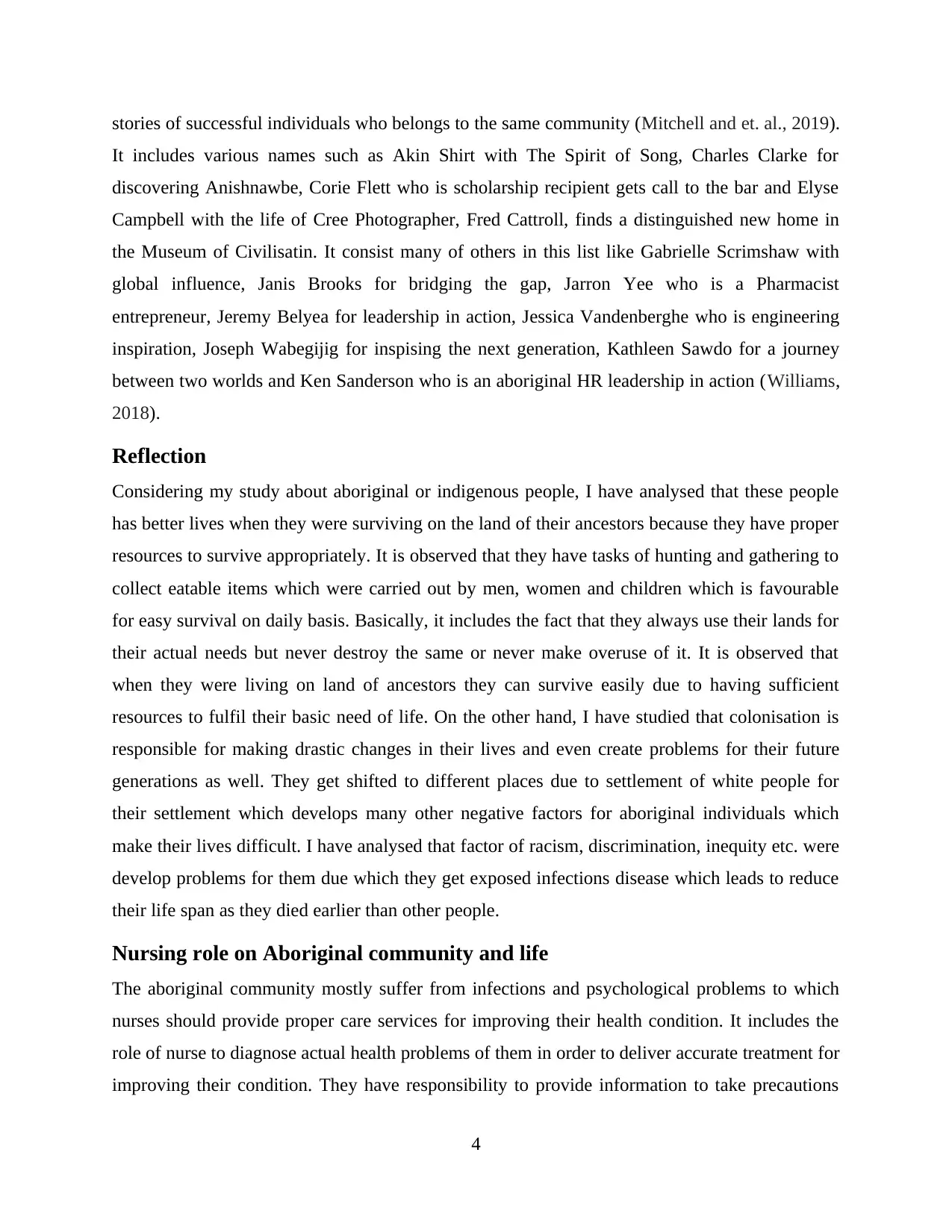
stories of successful individuals who belongs to the same community (Mitchell and et. al., 2019).
It includes various names such as Akin Shirt with The Spirit of Song, Charles Clarke for
discovering Anishnawbe, Corie Flett who is scholarship recipient gets call to the bar and Elyse
Campbell with the life of Cree Photographer, Fred Cattroll, finds a distinguished new home in
the Museum of Civilisatin. It consist many of others in this list like Gabrielle Scrimshaw with
global influence, Janis Brooks for bridging the gap, Jarron Yee who is a Pharmacist
entrepreneur, Jeremy Belyea for leadership in action, Jessica Vandenberghe who is engineering
inspiration, Joseph Wabegijig for inspising the next generation, Kathleen Sawdo for a journey
between two worlds and Ken Sanderson who is an aboriginal HR leadership in action (Williams,
2018).
Reflection
Considering my study about aboriginal or indigenous people, I have analysed that these people
has better lives when they were surviving on the land of their ancestors because they have proper
resources to survive appropriately. It is observed that they have tasks of hunting and gathering to
collect eatable items which were carried out by men, women and children which is favourable
for easy survival on daily basis. Basically, it includes the fact that they always use their lands for
their actual needs but never destroy the same or never make overuse of it. It is observed that
when they were living on land of ancestors they can survive easily due to having sufficient
resources to fulfil their basic need of life. On the other hand, I have studied that colonisation is
responsible for making drastic changes in their lives and even create problems for their future
generations as well. They get shifted to different places due to settlement of white people for
their settlement which develops many other negative factors for aboriginal individuals which
make their lives difficult. I have analysed that factor of racism, discrimination, inequity etc. were
develop problems for them due which they get exposed infections disease which leads to reduce
their life span as they died earlier than other people.
Nursing role on Aboriginal community and life
The aboriginal community mostly suffer from infections and psychological problems to which
nurses should provide proper care services for improving their health condition. It includes the
role of nurse to diagnose actual health problems of them in order to deliver accurate treatment for
improving their condition. They have responsibility to provide information to take precautions
4
It includes various names such as Akin Shirt with The Spirit of Song, Charles Clarke for
discovering Anishnawbe, Corie Flett who is scholarship recipient gets call to the bar and Elyse
Campbell with the life of Cree Photographer, Fred Cattroll, finds a distinguished new home in
the Museum of Civilisatin. It consist many of others in this list like Gabrielle Scrimshaw with
global influence, Janis Brooks for bridging the gap, Jarron Yee who is a Pharmacist
entrepreneur, Jeremy Belyea for leadership in action, Jessica Vandenberghe who is engineering
inspiration, Joseph Wabegijig for inspising the next generation, Kathleen Sawdo for a journey
between two worlds and Ken Sanderson who is an aboriginal HR leadership in action (Williams,
2018).
Reflection
Considering my study about aboriginal or indigenous people, I have analysed that these people
has better lives when they were surviving on the land of their ancestors because they have proper
resources to survive appropriately. It is observed that they have tasks of hunting and gathering to
collect eatable items which were carried out by men, women and children which is favourable
for easy survival on daily basis. Basically, it includes the fact that they always use their lands for
their actual needs but never destroy the same or never make overuse of it. It is observed that
when they were living on land of ancestors they can survive easily due to having sufficient
resources to fulfil their basic need of life. On the other hand, I have studied that colonisation is
responsible for making drastic changes in their lives and even create problems for their future
generations as well. They get shifted to different places due to settlement of white people for
their settlement which develops many other negative factors for aboriginal individuals which
make their lives difficult. I have analysed that factor of racism, discrimination, inequity etc. were
develop problems for them due which they get exposed infections disease which leads to reduce
their life span as they died earlier than other people.
Nursing role on Aboriginal community and life
The aboriginal community mostly suffer from infections and psychological problems to which
nurses should provide proper care services for improving their health condition. It includes the
role of nurse to diagnose actual health problems of them in order to deliver accurate treatment for
improving their condition. They have responsibility to provide information to take precautions
4
⊘ This is a preview!⊘
Do you want full access?
Subscribe today to unlock all pages.

Trusted by 1+ million students worldwide
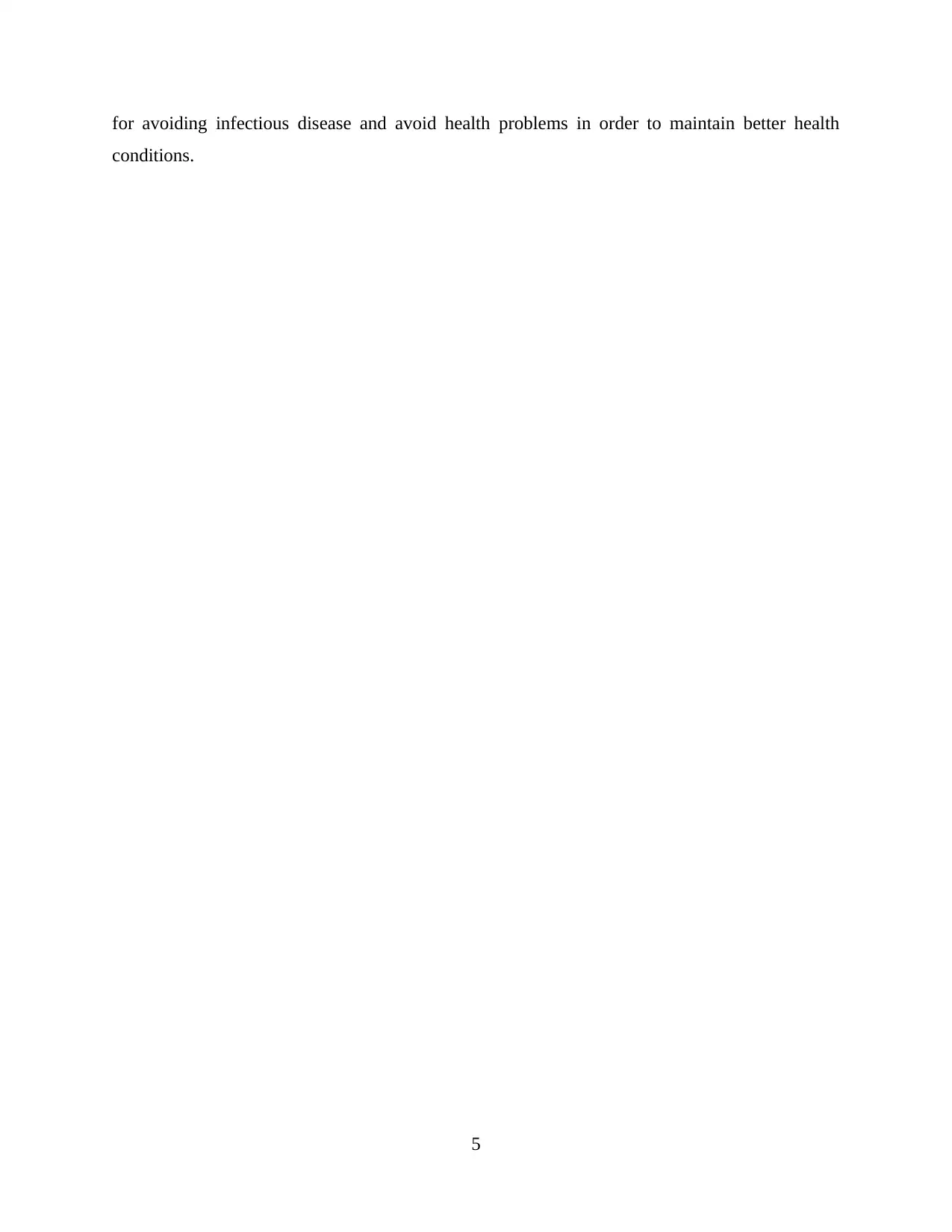
for avoiding infectious disease and avoid health problems in order to maintain better health
conditions.
5
conditions.
5
Paraphrase This Document
Need a fresh take? Get an instant paraphrase of this document with our AI Paraphraser
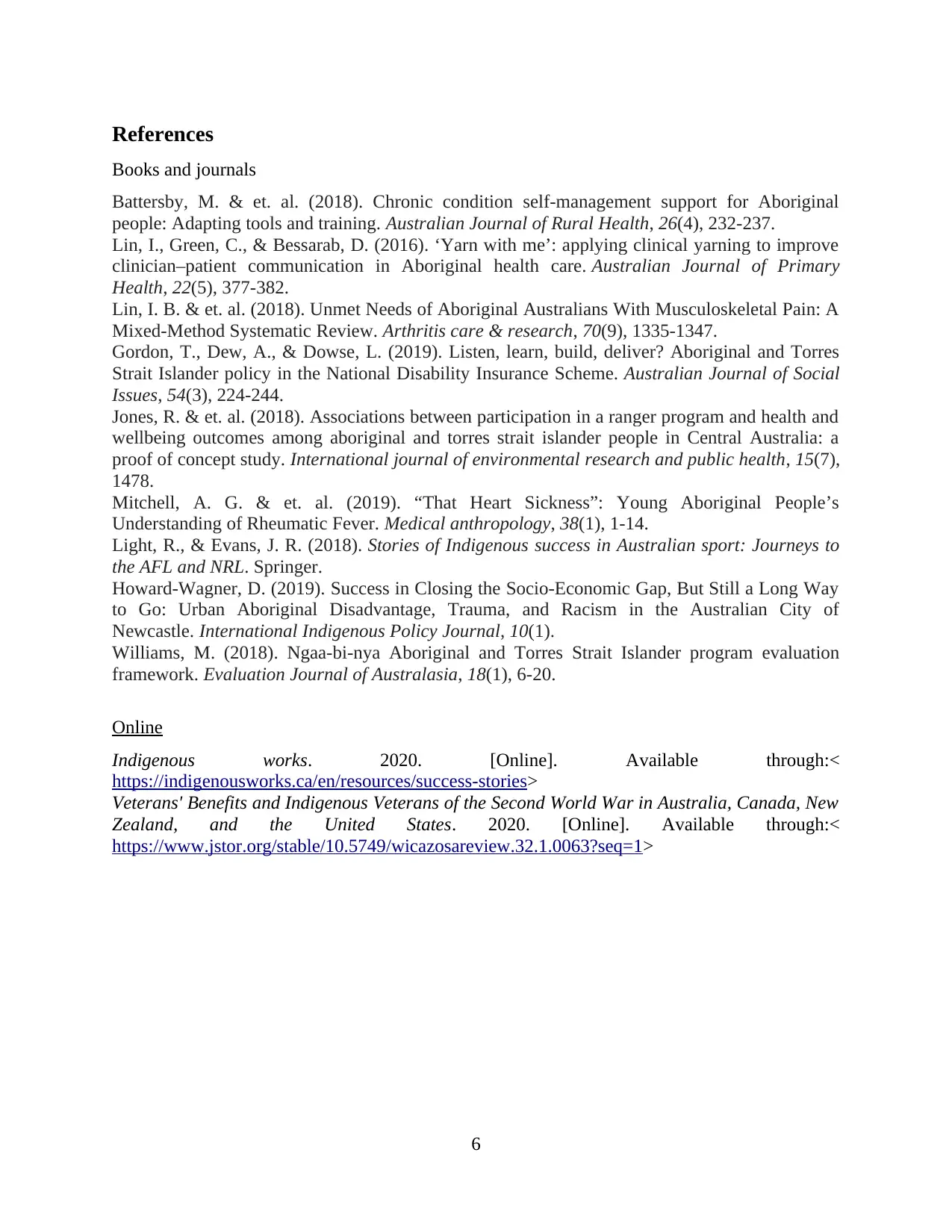
References
Books and journals
Battersby, M. & et. al. (2018). Chronic condition self‐management support for Aboriginal
people: Adapting tools and training. Australian Journal of Rural Health, 26(4), 232-237.
Lin, I., Green, C., & Bessarab, D. (2016). ‘Yarn with me’: applying clinical yarning to improve
clinician–patient communication in Aboriginal health care. Australian Journal of Primary
Health, 22(5), 377-382.
Lin, I. B. & et. al. (2018). Unmet Needs of Aboriginal Australians With Musculoskeletal Pain: A
Mixed‐Method Systematic Review. Arthritis care & research, 70(9), 1335-1347.
Gordon, T., Dew, A., & Dowse, L. (2019). Listen, learn, build, deliver? Aboriginal and Torres
Strait Islander policy in the National Disability Insurance Scheme. Australian Journal of Social
Issues, 54(3), 224-244.
Jones, R. & et. al. (2018). Associations between participation in a ranger program and health and
wellbeing outcomes among aboriginal and torres strait islander people in Central Australia: a
proof of concept study. International journal of environmental research and public health, 15(7),
1478.
Mitchell, A. G. & et. al. (2019). “That Heart Sickness”: Young Aboriginal People’s
Understanding of Rheumatic Fever. Medical anthropology, 38(1), 1-14.
Light, R., & Evans, J. R. (2018). Stories of Indigenous success in Australian sport: Journeys to
the AFL and NRL. Springer.
Howard-Wagner, D. (2019). Success in Closing the Socio-Economic Gap, But Still a Long Way
to Go: Urban Aboriginal Disadvantage, Trauma, and Racism in the Australian City of
Newcastle. International Indigenous Policy Journal, 10(1).
Williams, M. (2018). Ngaa-bi-nya Aboriginal and Torres Strait Islander program evaluation
framework. Evaluation Journal of Australasia, 18(1), 6-20.
Online
Indigenous works. 2020. [Online]. Available through:<
https://indigenousworks.ca/en/resources/success-stories>
Veterans' Benefits and Indigenous Veterans of the Second World War in Australia, Canada, New
Zealand, and the United States. 2020. [Online]. Available through:<
https://www.jstor.org/stable/10.5749/wicazosareview.32.1.0063?seq=1>
6
Books and journals
Battersby, M. & et. al. (2018). Chronic condition self‐management support for Aboriginal
people: Adapting tools and training. Australian Journal of Rural Health, 26(4), 232-237.
Lin, I., Green, C., & Bessarab, D. (2016). ‘Yarn with me’: applying clinical yarning to improve
clinician–patient communication in Aboriginal health care. Australian Journal of Primary
Health, 22(5), 377-382.
Lin, I. B. & et. al. (2018). Unmet Needs of Aboriginal Australians With Musculoskeletal Pain: A
Mixed‐Method Systematic Review. Arthritis care & research, 70(9), 1335-1347.
Gordon, T., Dew, A., & Dowse, L. (2019). Listen, learn, build, deliver? Aboriginal and Torres
Strait Islander policy in the National Disability Insurance Scheme. Australian Journal of Social
Issues, 54(3), 224-244.
Jones, R. & et. al. (2018). Associations between participation in a ranger program and health and
wellbeing outcomes among aboriginal and torres strait islander people in Central Australia: a
proof of concept study. International journal of environmental research and public health, 15(7),
1478.
Mitchell, A. G. & et. al. (2019). “That Heart Sickness”: Young Aboriginal People’s
Understanding of Rheumatic Fever. Medical anthropology, 38(1), 1-14.
Light, R., & Evans, J. R. (2018). Stories of Indigenous success in Australian sport: Journeys to
the AFL and NRL. Springer.
Howard-Wagner, D. (2019). Success in Closing the Socio-Economic Gap, But Still a Long Way
to Go: Urban Aboriginal Disadvantage, Trauma, and Racism in the Australian City of
Newcastle. International Indigenous Policy Journal, 10(1).
Williams, M. (2018). Ngaa-bi-nya Aboriginal and Torres Strait Islander program evaluation
framework. Evaluation Journal of Australasia, 18(1), 6-20.
Online
Indigenous works. 2020. [Online]. Available through:<
https://indigenousworks.ca/en/resources/success-stories>
Veterans' Benefits and Indigenous Veterans of the Second World War in Australia, Canada, New
Zealand, and the United States. 2020. [Online]. Available through:<
https://www.jstor.org/stable/10.5749/wicazosareview.32.1.0063?seq=1>
6
1 out of 8
Related Documents
Your All-in-One AI-Powered Toolkit for Academic Success.
+13062052269
info@desklib.com
Available 24*7 on WhatsApp / Email
![[object Object]](/_next/static/media/star-bottom.7253800d.svg)
Unlock your academic potential
Copyright © 2020–2025 A2Z Services. All Rights Reserved. Developed and managed by ZUCOL.





